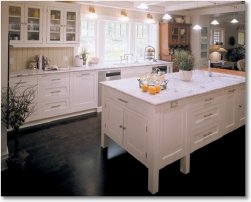Whether you're planning a simple kitchen spruce-up or a complete overhaul, deciding what to do about your cabinetry is one of the biggest decisions you'll make. New cabinets can take up nearly 50 percent of your total budget for a kitchen renovation, and functional cabinets can mean the difference between a kitchen that works and one that doesn't. But what if you can't afford to buy all-new cabinets with the latest storage features and styles?
Many homeowners today are saving money by "refacing" rather than completely replacing their existing kitchen cabinets.
There are three primary ways to reface cabinets:
1. Refinish or paint existing cabinet and drawer fronts.
2. Install new wood or laminate veneer over existing cabinet and drawer fronts.
3. Install completely new cabinet doors and drawer fronts.
In all three cases, new hardware such as hinges and pulls helps to complete the update. The interiors of the cabinets can also be sanded, painted or stained for a completely new look.
Fans of refacing say this mini-makeover can give a kitchen a whole new look at a much lower cost than installing all-new cabinets.
"Cabinet refacing can save up to 50 percent compared to the cost of replacing, " says Cheryl Catalano, owner of Kitchen Solvers, a cabinet refacing franchise in Napierville, Ill.
Cabinet refacing is also a much less involved process than removing old cabinets and installing new ones.
"Refacing is an ideal option for many people because of its convenience, " says Cheryl. "The process doesn't require removal of the appliances, so the kitchen stays functional while the work is being done."
Wide view of wooden kitchen cabinetry, kitchen island, appliances, stone columns, tiled flooring, and tile backsplash.
Even with the potential cost-savings, however, refacing isn't right for every kitchen remodel. Before making the decision to reface, rather than replace, homeowners need to consider a number of factors, starting with the "bones" of their current kitchen cabinetry.
"If they are not high-quality cabinets to begin with, it usually makes sense to replace the entire piece, " says Deborah Ramos, an interior designer in St. Petersburg, Fla.
Lorey Cavanaugh of Kitchen and Bath Design Consultants in Hartford, Conn., agrees.
"The old adage about not throwing good money after bad comes into play here, " Lorey says. "Don't spend money to refront products that are truly worn out."
Gary Reynolds, a cabinet craftsman in North Carolina, encourages homeowners to take a careful look at the quality of their existing cabinets before going with refacing.
"Cabinets built prior to the 1980s were generally built of better materials than newer ones. Back then, 3/4-inch plywood was actually 3/4 inches thick and particle board was used for floor underlayment, " explains Gary, who handles both refacing and new cabinet construction.
Another alternative for homeowners with older cabinets in good condition is to remove the doors altogether and convert their existing cabinets to open shelving. Interior shelves can be removed or reconfigured inside the existing cabinet frames for a thoroughly modern and updated look.
"(With conversion to open shelving) there is an opportunity to refinish interiors in another color from the exterior or add beadboard backs, " Lorey says.
However, even if your original cabinets are solidly built and in good condition, refacing or converting to open shelving may not be the best option if your current cabinet design or layout isn't efficient or functional. If the cabinets you have now aren't deep enough to hold your saucepans or tall enough to accommodate your cookie trays, replacing them completely may be the better option.














